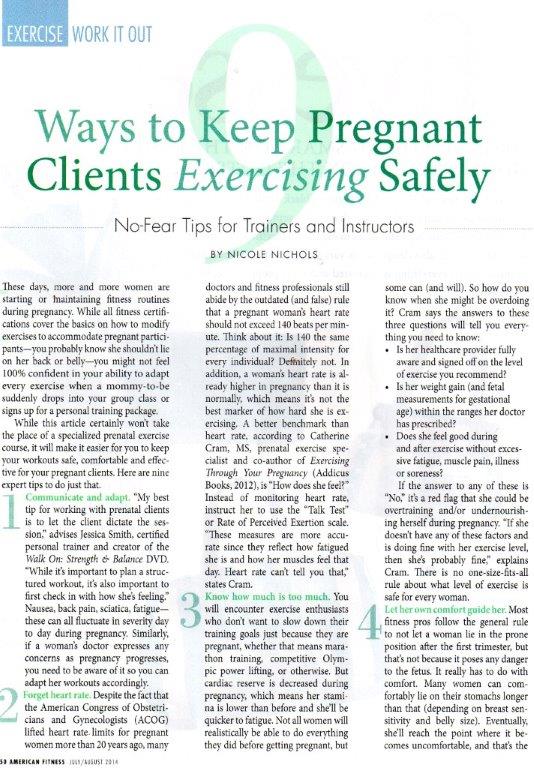These days, more and more women are starting or maintaining fitness routines during pregnancy. While all fitness certifications cover the basics on how to modify exercises to accommodate pregnant participants—you probably know she shouldn’t lie on her back or belly—you might not feel 100% confident in your ability to adapt every exercise when a mommy-to-be suddenly drops into your group class or signs up for a personal training package.
While this article certainly won’t take the place of a specialized prenatal exercise course, it will make it easier for you to keep your workouts safe, comfortable and effective for your pregnant clients. Here are nine expert tips to do just that.
1. Communicate and adapt.“My best tip for working with prenatal clients is to let the client dictate the session,” advises Jessica Smith, certified personal trainer and creator of the Walk On: Strength & Balance DVD. “While it’s important to plan a structured workout, it’s also important to first check in with how she’s feeling.” Nausea, back pain, sciatica, fatigue—these can all fluctuate in severity day to day during pregnancy. Similarly, if a woman’s doctor expresses any concerns as pregnancy progresses, you need to be aware of it so you can adapt her workouts accordingly.
2. Forget heart rate. Despite the fact that the American Congress of Obstetricians and Gynecologists (ACOG) lifted heart rate limits for pregnant women more than 20 years ago, many doctors and fitness professionals still abide by the outdated (and false) rule that a pregnant woman’s heart rate should not exceed 140 beats per minute. Think about it: Is 140 the same percentage of maximal intensity for every individual? Definitely not. In addition, a woman’s heart rate is already higher in pregnancy than it is normally, which means it’s not the best marker of how hard she is exercising. A better benchmark than heart rate, according to Catherine Cram, MS, prenatal exercise specialist and co-author of Exercising Through Your Pregnancy (Addicus Books, 2012), is “How does she feel?” Instead of monitoring heart rate, instruct her to use the “Talk Test” or Rate of Perceived Exertion scale. “These measures are more accurate since they reflect how fatigued she is and how her muscles feel that day. Heart rate can’t tell you that,” statesCram.
3. Know how much is too much.You will encounter exercise enthusiasts who don’t want to slow down their training goals just because they are pregnant, whether that means marathon training, competitive Olympic power lifting, or otherwise. But cardiac reserve is decreased during pregnancy, which means her stamina is lower than before and she’ll be quicker to fatigue. Not all women will realistically be able to do everything they did before getting pregnant, but some can (and will). So how do you know when she might be overdoing it? Cram says the answers to these three questions will tell you everything you need to know:
- Is her healthcare provider fully aware and signed off on the level of exercise you recommend?
- Is her weight gain (and fetal measurements for gestational age) within the ranges her doctor has prescribed?
- Does she feel good during and after exercise without excessive fatigue, muscle pain, illness or soreness?
If the answer to any of these is “No,” it’s a red flag that she could be overtraining and/or undernourishing herself during pregnancy. “If she doesn’t have any of these factors and is doing fine with her exercise level, then she’s probably fine,” explains Cram. There is no one-size-fits-all rule about what level of exercise is safe for every woman.
4. Let her own comfort guide her.Most fitness pros follow the general rule to not let a woman lie in the prone position after the first trimester, but that’s not because it poses any danger to the fetus. It really has to do with comfort. Many women can comfortably lie on their stomachs longer than that (depending on breast sensitivity and belly size). Eventually, she’ll reach the point where it becomes uncomfortable, and that’s the time to avoid prone exercises. Also keep in mind that even very early in the first trimester (before her belly is large enough to cause discomfort), she could be experiencing breast tenderness that makes even “safe” exercises painful. Speak to that in your sessions and provide an alternative: “If lying face down is too uncomfortable here, try this exercise instead.”
5. Watch for high-risk symptoms. You’re not a doctor, but it is your responsibility to recognize when a woman should stop exercising immediately and call her doctor. These signs include:
- Amniotic fluid leakage
- Calf pain or swelling (thrombophlebitis)
- Chest pain
- Decreased fetal movement
- Dizziness
- Dyspnea (shortness of breath) prior to exertion
- Headache
- Muscle weakness
- Preterm labor
- Vaginal bleeding
6. Add functional exercises. During pregnancy, a woman’s breasts will gain 1 to 2 pounds each, which can pull her shoulders forward and tighten the chest, rounding the upper back into a kyphotic curve. As her belly increases in size, she’s also likely to experience lordosis (lumbar spine hyperextension) and lower back pain. Include specific exercises to help counter kyphosis (such as chest and anterior shoulder stretches; upper back and posterior shoulder strengtheners) plus train the transverse abs for stability while stretching the glutes and hamstrings to prevent back pain associated with lordosis.
To prepare for delivery, weave Kegel exercises into your workouts, suggests Kim Truman, a Dallas-based personal trainer and group fitness instructor. “Kegels help maintain a strong pelvic floor and strengthen and tone the pubococcygeal (PC) muscle,” which can help during delivery and postpartum recovery. Instruct clients to perform a set of 5 to 12 Kegels, feeling the contraction and release for each, she advises.
To prepare for postpartum, strong arms to lift and hold baby are a must. Also include functional exercises that will help her lift and carry baby in good form. For example, squatting (instead of bending) to pick a weighted ball off the floor and carrying it close to one’s body will help a mom develop muscle memory and strength to continue that same movement once baby arrives.
7. Be mindful of balance.During pregnancy, a woman’s center of gravity shifts upward and outward, which throws off her balance and coordination. “Pregnancy is definitely not the time to bring out the BOSU® or unstable surfaces,” cautions Smith. While balance training is important to help offset these changes, keep things simple. Avoid the balance boards and props that increase the risk of falling. Move unilateral exercises near a wall or stable surface (or try them seated). Suggest a wider leg stance for greater stability in any exercise.
8. Continue exercising normally—if she did it before, she can (probably) do it now. Generally speaking, almost any exercise program your client followed before pregnancy is safe to continue during pregnancy. “There are very few absolute contraindicated exercises for pregnancy, as research has found that in an uncomplicated pregnancy the fetus is well protected within the uterus,” says Cram. Instead of fearfully avoiding exercises, use your skills and creativity to find modifications that enable an exercise that’s become uncomfortable to be tweaked so that your client can continue with it. The few exercises ACOG advises against are typically those that involve extreme temperatures (such as heated yoga), high altitudes, and a high risk of falls or trauma to the fetus, including contact sports, horseback riding and skiing.
9. Embrace the beginner. “Pregnancy often motivates women to do things that are healthy for their lifestyle, like starting an exercise program,” observes Cram. “Don’t be afraid of working with someone just because she is pregnant.” The challenge of training a pregnant woman who is new to fitness isn’t that exercise is unsafe (as long as she has doctor’s clearance). It’s that she doesn’t already know what it feels like to exercise—and breathing heavy, elevating her heart rate and sweating might be overly concerning to her especially since she’s pregnant. Give extra cues about what she might be feeling and what is normal to experience during exercise so that it’s not alarming. Teach her how to listen to her own body. “There’s nothing to be afraid of if her physician is on board and she’s feeling fine,” Cram reassures regarding a pregnant woman who is starting an exercise program.
There aren’t a lot of absolute rules about which exercises are safe or unsafe during pregnancy—it’s very unique to the individual. But if you’ve never been pregnant yourself (or trained many pregnant clients), there are some exercises that you may be surprised to learn are uncomfortable or difficult during pregnancy. Be prepared to modify the movements listed below with the pictured alternatives depending on your client’s needs.
1. Instead of a Pilates Roll-Up (or a Full Sit-Up) According to Ellen Barrett, creator of the Happy Baby, Fit Mamaworkout DVD, this movement can be very uncomfortable even during early pregnancy. Instead, she suggests working the core through subtler standing balance exercises, such as Tree pose (keep a chair or wall handy for balance just in case).
2. Instead of BOSU or Balance Board Exercises To improve balance safely (without a high risk of falling), try split-stance movements, such as this row, which also trains the upper back, advises Smith. “With one leg slightly in front of the other, she can safely challenge her balance.”
3. Instead of Yoga’s Boat Pose or The Pilates Hundred Extending the legs during abdominal work isn’t unsafe, but it can put too much stress on the lower back and that’s not as effective at training the abs as pregnancy progresses. Modify these movements with bent knees, suggests Elizabeth Ordway, star of the Element: Targeted Toning Pilatesworkout DVD.
4. Instead of Lunges Cram explains that the increased weight of pregnancy (20 to 35 pounds or more) can easily lead to knee and back discomfort during loaded movements. Reduce or omit the added resistance, decrease the depth of the lunge, and/or keep a chair nearby so she can support herself when returning to standing without joint discomfort.
5. Instead of Deep and/or Unsupported Squats Like lunges, squats can be uncomfortable for some moms-to-be, and become increasingly difficult later in pregnancy when the muscles of the hamstrings and back tighten. Modify by holding on to a stable surface, reducing the ROM or providing a way for the mom to help pull herself back up from the squat, such as the TRX® option pictured here.
6. Instead of Unsupported Exercises on a Ball Including more stability ball exercises is common during pregnancy, especially as alternatives to lying supine on a bench or floor. Because balance is challenged during pregnancy, getting on and off the ball (and even balancing on the ball) might be surprisingly difficult for your client. Modify by deflating the ball to give it more stability, placing the ball on a stand for safety, and/or placing the ball in a corner so it’s less likely to roll.
7. Instead of Closed Twists Such as Warrior I or Med Ball Twists A twist (spinal rotation) usually feels good, but deep twists from the abdominal area can feel restrictive for the baby, and “can increase pain in the SI joint, which is particularly vulnerable during pregnancy,” says Christy Plaugher, master trainer for YogaFit. Instead, try “open” twists that create space (such as twisting away from the knee in the spinal twist pictured) or spinal rotations that only rotate the upper spine. AF




